Part 2: 'This Has Got To Beat Firecrackers'
By: Wes Oleszewski
For the first four days of the STS-4 mission there was very little heard by the public about the flight. Apparently their top-secret DOD payload work was causing NASA to keep a tight lid on the mission. Daily press conferences with flight directors were peppered with statements such as, “We can’t talk about that.” “That’s something we can’t talk about.” “Can’t answer that.” and of course “No comment.” At one point Flight Director Harold Draughon was asked by a reporter if they had ever considered sending up just an empty black box that did nothing and then say they can’t talk about it; just to test the secrecy. Draughon chuckled and answered “Maybe that’s what’s in there.” Oddly, the reporter’s question hit close to the truth. The top secret P-82-1 payload package, A.K.A. “CERRIS” actually ended up doing almost nothing other than test the secrecy.
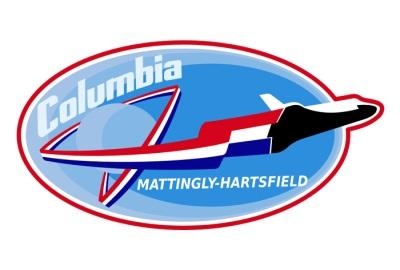
CERRIS, which was an acronym for Cryogenic InfraRed Radiance Instrumentation for Shuttle, was supposed to be able to sense the heat signatures of boosting Soviet missiles and provide early warning. One sensor in the package looked for booster exhaust and another was supposed to send ultraviolet radiation against the earth’s horizon. The package, however, had two doors that covered the sensors. During the flight one of the doors failed to open and so that part of the exercise was a complete bust. There is some debate as to the other part of the package, the Horizon Ultraviolet Program (HUP) experiment, and whether it worked or not also. Obscure references indicate that at least some data was gained from the HUP experiment, but it was probably nothing near what DOD had in mind. Thus, instead of a black box that did nothing, the crew of STS-4 ended up with a white package that did… almost nothing. Of course there could have been more aboard STS-4 than the CERRIS and that information
could still be classified, we will leave that up to the black-projects buffs to discuss.
As another part of the security for the flight the crew spoke to a special sort of CapCom on the ground as well as the normal CapCom in Houston. The special communicator was designated as the “PayCom” for Payload Communicator and was located at the National Reconnaissance Office (NRO) in Sunnyvale, California. Most messages from the PayCom were spoken in code that referred to a top-secret checklist that was carried aboard the Columbia. The checklist itself was stored in a “safe” which was actually a drawer aboard the orbiter that had a padlock on it. The astronauts unlocked the drawer once in orbit to remove the top-secret checklist and then would be directed by the PayCom to select a specific page which would have their next task written on it. Orders would be called up such as “Perform Tab Bravo” and the crew would go to that section and run the procedure. Reading their accounts of the mission you get the impression that the whole exercise became somewhat of
a pain for the crew. Finally, after the CERRIS had fully demonstrated that it was a pretty much flop and that part of the mission appeared to be finished, Hartsfield went down and fully stowed the secret items into the “safe.” It was a task that took a good bit of time and work. That was because items packed in one-G and then unpacked in zero-G have a tendency to not want to fit back into their original space. Finally he finished packing, locked the “safe” and floated up to report to Mattingly that he had finished the task. In his 12, June 2001 NASA oral history account of the event Hartsfield said that not 20 minutes after he had finished, PayCom called and ordered that he “…wanted me to do Tab November.” Neither astronaut could recall what Tab November was. So, Hartsfield had to go down, unlock the “safe” and dig out the checklist and flip to “Tab November.” It said to put everything away and stow the checklist.
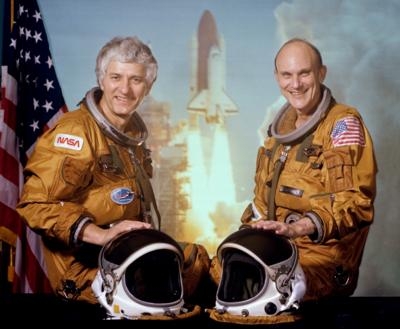
Starting on Day 4 the STS-4 mission went back into a near-normal mode for flight testing of the vehicle, as well as a variety of non-secret scientific experiments that needed to be done. Everything from structural heating tests, similar to those done on STS-3, to “plume surveys” took place over the last two full mission days. In all there were 16 scientific tests and 63 vehicle test that were to be conducted. The biggest disappointment, besides the CERRIS package, was the Induced Environment Contamination Monitor, which suffered from design flaws. Overall, however, NASA determined post-flight that the STS-4 mission had accomplished 90% of its objectives.
Day 7 was the reentry and landing day and it was all going to take place at Edwards Air Force Base on the 4th of July holiday. The day was made extra special because President and Mrs. Reagan were to attend the landing. Additionally, NASA used the event to show off the newest orbiter in the fleet- the Challenger. She was atop the 747 Shuttle Carrier Aircraft (SCA) and scheduled to depart shortly after the Columbia arrived. In his 22 April, 2002 NASA Oral History interview Mattingly said, "… they wanted to make sure that we landed on the fourth of July. It was no uncertain terms that we were going to land on the fourth of July, no matter what day we took off. Even if it was the fifth, we were going to land on the fourth. [Laughter] that meant, if you didn't do any of your test mission, that's okay, as long as the land on the fourth, because the president is going to be there." He went on to explain that the crew had met for lunch with the NASA administrator the day before launch day and
the administrator made sure to remind them to have something to say for the president after they landed. "We never came up with something we could say," Mattingly recalled, "but we came up with a whole lot of humor that we didn't dare say."
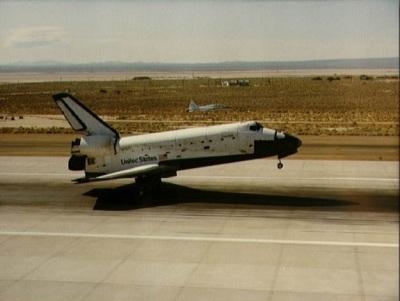
Reentry went normally as did most of the approach- but later Mattingly’s luck would change a little bit for the worst. Unlike STS-3, this profile was similar to those that would be flown on future operational missions. Mattingly, like all Shuttle CDRs since the first free-flight test of the Enterprise, was intending to allow Hartsfield fly a portion of the Heading Alignment Circle (HAC). As Mattingly intercepted the HAC and began the turn he turned his head toward Hartsfield preparing to say “…okay, here, take it for a bit…” He recalled that at that instant, “…suddenly my (sense of balance) gyros tumbled and I just had the worse case of vertigo I’ve ever had. Broad daylight. It was really overwhelming.” Instinctively, he went back onto his instruments and rebalanced his senses by focusing there. Puzzled, Hartsfield asked, “Are you gonna let me fly?” Mattingly simply responded, “No, no. I can’t talk about it now.”
Later he would explain to his PLT what had happened. No doubt Hartsfield understood fully as, any professional pilot would. The landing turned into a greaser, in fact both astronauts were unsure if the wheels had actually contacted the runway, but there they were rolling along. Hartsfield had to remind Mattingly to go ahead and put the nose down. Mattingly later recalled “I’d never been able to do that again in any airplane. Never did it before.”

Once the Columbia had fully stopped and the final checklists were completed, the two astronauts removed their helmets and tried to get out of their seats. Both found it excessively difficult to move- a full week in zero-G was allowing gravity to take its revenge upon them. Mattingly seemed to be suffering from it the worst as he struggled to get up out of his seat. Finally, frustration took over and he just pushed up as hard as he could. The effort cost him as he regained his ability to stand at the same moment and drove himself, head first, minus his helmet, into the overhead suffering a cut as a result. He later recalled “…blood was coming out. It was terrible. Oh, did I have a headache.” To make matters worse, the person waiting for him at the bottom of the stairs would be President Reagan. Of course Mattingly got it all together before the two Shuttle pilots left the orbiter and met the President in front of the TV cameras. Those of us watching at home that day saw the crew come
out, meet the President and First Lady and do a short walk-around the Columbia. Mrs. Reagan did what any of us would have done if given the chance- she walked over and touched the orbiter.
Later in the day President Reagan gave a speech about our nation’s future in space, with the orbiter Enterprise as a backdrop. He spoke in specific terms about the Shuttle and declared the STS to be “Fully operational.” Shortly thereafter he made the call that the Challenger, which had been in position and holding at the end of the runway was “…free to take off now!” With that Fitz Fulton put the throttles on the SCA forward and the spacecraft and her mother ship majestically began to roll as the crowd cheered. Next the STS-4 crew said a few words. Mattingly, a man of few words in public, made a very profound comment that captured the exact mood at that moment in history. He said about the Shuttles, in part, “…the machine we built is the first stepping stone. Here comes the second one (pointing toward Challenger), we’re standing in front of its pathfinder and there’s more to come.” The SCA roared past as the crowd cheered and
screamed. Indeed there WAS more to come- after seeing our nation’s space program wither at the end of Apollo, after watching space program critics from Capitol Hill to the news media call for the outright cancellation of the Shuttle- after seeing the Kennedy Space Center turned into little more than a side-trip after a visit to Disney World, there was the very real feeling that WE WERE BACK in space. And now with our magnificent Shuttle machines, we Americans would lead the world in spaceflight from now on.
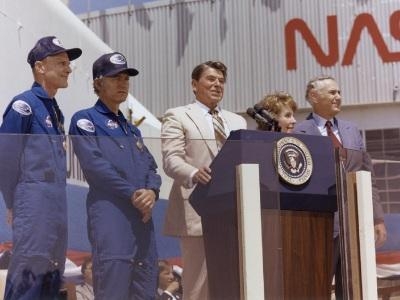
Following Mattingly and Hartsfield’s speeches, President Reagan returned to the microphone. He said a few parting words and then, as the SCA came around for a second low pass, the band (yes, there was a band there- after all it was the 4th of July holiday) was cued to strike up "God Bless America." President Reagan began to sing (without a teleprompter... ahem) "God Bless America" and the entire crowd, including the STS-4 crew, joined in. Reagan, being a former actor, was a good singer too and he just rolled along singing and proudly smiling as the Challenger and SCA passed by. It gives you shivers to watch that on video 30 years later. What a time that was for spaceflight. The Soviets were launching the Soyuz at the rate of nearly 2 a week, we had an operational Shuttle on the runway and another on the SCA headed for KSC, plus 2 more in the barn getting ready to fly, NASA was talking about 30 flights a year in the decade ahead and the US Air Force was constructing their own Shuttle pad at
Vandenberg- it was an exciting time- no doubt. After the SCA passed, the President turned to the STS-4 crew and said "that could puddle you up." He was right, it was a scene that made your spirit soar as the TV screen was filled with the silver 747, with its red, white and blue stripe proudly flying buy with America’s newest space shuttle on its back. It all seemed to say what the President had highlighted in his speech- reminding the nation that we Americans can do anything, because “…we’re a prosperous people, we’re a strong people, because we’re a FREE people.” He then concluded the event by saying to the crowd and to the nation, "Happy 4th of July and you know this has got to beat firecrackers.” The crowd went nuts.
At that time I was a college student at the Embry Riddle Aeronautical University, working my way through school by earning minimum wage at the Daytona K-mart store’s garden shop- loading bags of pine bark nuggets and cow manure and living like a college kid. Watching the events surrounding the STS-4 landing, I was proud to be an American at that moment.
A few days earlier, with the 4th of July coming up, someone had given me a large bottle rocket to celebrate. Inspired by the STS-4 launch, which I had attended, I decided that a better use for the big bottle rocket was as a little Shuttle booster. I painted it ET orange, made some little mock SRBs and then, to make it even more fun, I scratch-built a tiny orbiter out of paper and a little bit of balsawood, to ride on the bottle rocket. I rigged a make-shift hook on the nose of the orbiter that went under the plastic nosecone of the rocket- so that at report, the orbiter could just release and fly. I trimmed the bottle rocket stick to the booster length squared (optimum for stability and altitude) and then had the whole thing sitting on my desk as a display to my own insanity.
On the July 4th I watched the STS-4 landing on TV with two of my friends from school, Dan and Joe. It was Florida hot out and our house had no air conditioning, so later on we were sitting around and the other two guys were getting very happy drinking rum and cokes- since I’m a lifelong non-drinker I just hung out and enjoyed the fact that there was no cow manure to haul today. As the day went on they got more and more “happy” and started bugging about my fireworks Shuttle. I demonstrated in a toss how well the orbiter flew and that resulted in additional pestering about launching it. After an afternoon of drunken dares, pestering and nagging they shifted to saying it would be a great way to “celebrate” STS-4… how could I say no? By now these two guys were too stoopered to drive to any launching site and so it was decided to launch from the front yard. Our house, on Daytona Avenue in Holly Hill, was heavily covered by very large trees, so I got one of the dozen or
so coke bottles they’d emptied, put my bottle-rocket Shuttle stack on it and aimed for biggest hole in the tree canopy.
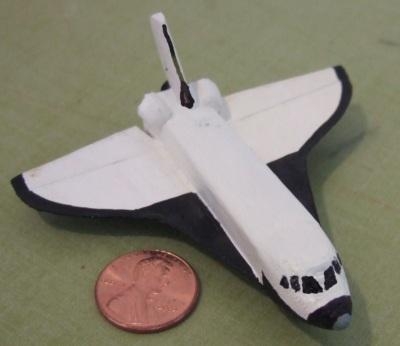
Unexpectedly, bottle rocket shot up through a different hole in the trees and out of sight. We heard the fireworks “pop!” which everyone was sure signaled the end of my mini STS-4. My two pals were roaring with drunken laughter- one doubled over and the other on the ground. I, however, being the long time model rocketeer, instinctively scanned the trees in the hope that some pieces may drop through. Then, suddenly, through the hole in the tree canopy I had been aiming for, but missed at launch, my little orbiter came gliding as if being piloted. For a second we all sort of stood there in amazement as the orbiter flew past us just overhead and landed in the yard next door as pretty as can be. There was a moment of “NO WAY!” gasping and then I trotted over giggling in amazement and brought my orbiter back in the palm of my hand. I never did find any of the booster parts, but I kept the orbiter and still have it.
Unfortunately, 30 years after STS-4, although I may still have that silly little orbiter, our nation no longer has its dominance in human spaceflight. The real Shuttles are gone from flight status and rapidly being converted into museum pieces. While China and Russia can readily launch humans into space, the “leadership” our nation has once again degraded our own human spaceflight program to the point where we can only send astronauts to the International Space Station in the exact same manner as “space tourists” have done in the past; by renting seats on Soyuz. It is something I could never have imagined as I watched STS-4 come back. Thus, today I am going to go out and launch my little orbiter again for the first time in 30 years. At least mine can still fly.
(All images except mini-shuttle provided by NASA. Mini-shuttle photo courtesy Wes Oleszewski)
 SpaceX to Launch Inversion RAY Reentry Vehicle in Fall
SpaceX to Launch Inversion RAY Reentry Vehicle in Fall Aero-News: Quote of the Day (04.23.24)
Aero-News: Quote of the Day (04.23.24) Aero-News: Quote of the Day (04.20.24)
Aero-News: Quote of the Day (04.20.24) ANN's Daily Aero-Linx (04.20.24)
ANN's Daily Aero-Linx (04.20.24) Aero-News: Quote of the Day (04.21.24)
Aero-News: Quote of the Day (04.21.24)








